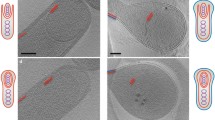Abstract
High concentrations of NaCl and divalent cations were required for the stabilization of Haloferax volcanii envelopes. When the divalent cation concentration was lowered, the envelopes lost their angular shape and rouded up and the S-layer detached. When the combination of salts was just below the minimum enabling the envelope stabilization, partial rounding up and loss of the S-layer were observed. After a few days, a spontaneous and continuous reorganization of the envelope material occurred leading to the formation of geometrical envelope-like structures. This process could be stopped by either lowering the divalent cation concentration or by cooling the preparation, and resumed by restoring the initial conditions.
Similar content being viewed by others
References
Alam M, Oesterhelt D (1987) Purification, reconstitution and polymorphic transition of halobacterial flagella. J Mol Biol 194: 495–499
Blaurock AE, Stoeckenius W, Oesterhelt D, Sherphof GL (1976) Structure of the cell envelope of Halobacterium halobium. J Cell Biol 71: 1–22
Buckmire FLA, Murray RGE (1976) Substructure and in vitro assembly of the outer, substructured layer of Spirillum serpens. J Bacteriol 125: 290–299
Cohen S (1987) Characterisation of the growth physiology and the influence of divalent cations on the envelope of halobacteria from the Dead Sea. Ph.D. Thesis. The Hebrew University. Jerusalem, Israel
Cohen S, Oren A, Shilo M (1983) The divalent cation requirement of Dead Sea halobacteria. Arch Microbiol 136: 184–190
Cohen S, Kessel M, Shilo M (1991) Nature of the salt dependence of the envelope of a Dead Sea archaebacterium, Haloferax volcanii. Arch Microbiol 156: 198–203
Kessel M, Wildhaber I, Cohen S, Baumeister W (1988) Three-dimensional structure of the regular surface glycoprotein layer of Halobacterium volcanii from the Dead Sea. EMBO J 7: 1549–1554
Mescher MF, Strominger JL (1976) Structural (shape-maintaining) role of the cell surface glycoprotein of Halobacterium salinarium. Proc Natl Acad Sci USA 73: 2687–2691
Messner P, Sleytr UB (1992) Crystalline bacterial surface layers. In: Rose AH, Tempest CDW (eds) Advances in microbial physiology, vol 33. Academic Press, London, pp 213–274
Messner P, Hollaus F, Sleytr UB (1984) Paracrystalline cell wall surface layers of different Bacillus stearothermophilus strains. Int J Systs Bacteriol 34: 202–210
Messner P, Pum D, Sara M, Stetter KD, Sleytr UB (1986) Ultrastructure of the cell envelope of the Archaebacteria Thermoproteus tenax and Thermoproteus neutrophilus. J Bacteriol 166: 1046–1054
Mullakhanbhai MF, Larsen H (1975) Halobacterium volcanii spec. nov. A Dead Sea halobacterium with a moderate salt requirement. Arch Microbiol 104: 107–214
Sleytr UB, Messner P (1983) Crystalline surface layers on bacteria. Annu Rev Microbiol 37: 311–339
Sleytr UB, Messner P, Sara M, Pum D (1986) Crystalline envelope layers in archaebacteria. Syst Appl Microbiol 7: 310–313
Author information
Authors and Affiliations
Additional information
Deceased 1990
Rights and permissions
About this article
Cite this article
Cohen, S., Shilo, M. & Kessel, M. In vitro spontaneous reorganization of Haloferax volcanii envelope material into geometrical forms. Arch. Microbiol. 160, 248–252 (1993). https://doi.org/10.1007/BF00249132
Received:
Accepted:
Issue Date:
DOI: https://doi.org/10.1007/BF00249132




